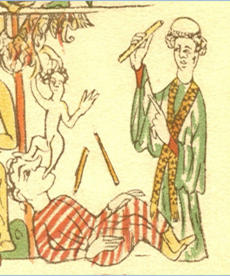(C20) From Expulsion to Social Death

Political and Religious Expulsion Proceedings in the Middle Ages
It is the ideal of all communities to guarantee its members a protected space of law and peace and to sanction possible offences against the social order. In medieval society, there weren’t any – in modern terms − “executive organs” available in this context in order to prosecute an offender and to enforce compliance with a punishment. In these cases, expulsion from the legal and peace community was the result. Such exclusion meant that the person thus punished lost the rights and the benefits that secured the survival of the remaining members of the group. In some cases, expulsion even went to such lengths as to refer to the punished ones as dead. They did not die a physical death, however, but a social, political and economic one – in short, they suffered a fate that could be called “social death”. The basis of this categorisation is formed by the idea that death is not only a biological phenomenon, but that it is also determined by a society’s cultural practice. A person, as a physical individual, thus dies a biological death; at the same time, he dies as a member of a social community. Biological and social death may be congruent here, but they may also be separate from one another. This means that, on the one hand, both biologically living persons and biologically deceased persons may be treated in a way so that any ties to them are broken. On the other hand, however, physical death may be ignored as an alleged break by continuing to maintain the ties with the deceased, the living forming a community around the dead.
The practice of expulsion and of “social death” developed this way provides an important informative basis for understanding the medieval community. The cohesive principles of pre-modern social orders are crucial for the interpretation of these conceptions: They easily convey how serious an expulsion was. Most notably in communities whose coherence was ensured through personal ties, the existence of the individual depended on his membership in appropriate social and political networks. In communities which were not supported by governmental or public institutions and organisations but which were structured by such personal ties, integration into different groups decided on if and how the individual survived.
The procedure of punishing offenders with expulsion from society or even with “social death” can be encountered on different levels in medieval centuries. In the context of the practice of secular rule it can be seen as peacelessness and outlawry, and it is encountered as excommunication in the religious realm. Outlawry was a procedural coercive measure if a delinquent declined both a court hearing and an amicable agreement. If the outlaw was compliant, acknowledged his wrong conduct and was willing to compensate, the consequences of outlawry were obsolete. In this, the secular expulsion procedure resembled the religious one to an astonishing degree. Here, too, expulsion was impending in the case of a severe offence, namely in such cases in which the believer was obdurate and defied gratification. There were also several degrees of isolation, ranging from partial to total expulsion and finally leading to “social death”. Such measures could only then develop a lasting effect if both proceedings were interconnected, if isolation thus spanned the whole existence of the offender. Ideally, therefore, excommunication and outlawry had to intertwine. Thus, the reciprocal imposition of “outlawry and ban” was an expression of the conviction that only parallel secular and sacral expulsion could discipline a person.
Although both the religious and the secular expulsion procedure allow fundamental insights into the functionality of the pre-modern social order, there are few systematic studies on this subject area available so far. Therefore, the project not only deals with the chronological development and the procedural methods of the described expulsion mechanisms, but it also enquires into the reciprocal impulses of both forms.

